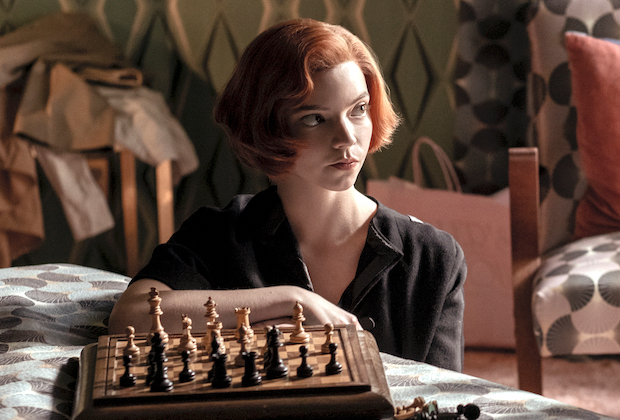The Queen’s Gambit Review
December 7, 2020
The Queen’s Gambit is an opening chess move, and it is very popular because of its attacking prowess. In this move, the player sacrifices a pawn to gain control of the whole board, putting pressure on the opponent to defend themselves with proper and precise techniques. “The Queen’s Gambit” is also the name of a Netflix Original miniseries, directed by Scott Frank, and follows the journey of an orphaned child chess prodigy, played by Anya Taylor-Joy, who also struggles with addiction. The miniseries is based on a book of the same name, written by Walter Tevis. While the show has stayed very close to the book, the writers have taken some creative liberties with parts of it.
The story begins in 1950’s Kentucky as nine year old Beth Harmon is taken to an orphanage after getting into a violent car crash with her mother. There are several time skips as the audience follows the journey of her learning the world of chess and aiming to become the World Champion, while also struggling with her addiction to sleeping pills and alcohol.
I’ll be honest. I could only keep track of the time skips through the length of Beth’s hair. It grows as time goes on and gets more and more styled as the young girl grows into herself. They could have added more subtitles, or screen text to suggest how much time had passed, but the show did well enough even without those clues.
While this may seem a small deal to mention, Beth’s fashion also does a good job of letting us know of the time skips. She is wearing something more fashionable every time we circle back to her, showing she has grown into herself more and more with each passing year. She is still a child, who is still figuring out who she wants to be, and it is clear through her fashion choices that Beth cares more about how she presents herself as she ages. She also takes inspiration from some of her role models as well – whether that be the school’s queen bee or the french model she is captivated by.
The beautiful and timely fashion was a detail I really enjoyed. Beth loved fashion, even as she spent more and more time obsessed with chess. As the show progresses, her clothing helps contrast her from the older men she plays chess against. It would have been very easy for Frank to make Beth seem “not like other girls,” and make that a cheap feminism statement for Beth. Instead though, she embraces her femininity, and that helps further emphasize the difference between her and her female peers.
Ultimately, it is telling of the show’s better qualities that the director doesn’t feel the need to do so. Her friendships and relationships with other women and her femininity are mostly loving, supportive and healthy. The story refuses to lean into the sexist and age old “women can only bring drama” cliche. In the end, the main conflict of the story is with herself and her addiction.
The feminism aspect of “The Queen’s Gambit” is very well done. It is not the center focus of her success, and it is not the main obstacle she has to cross to achieve her ultimate goal either. While Beth’s opponents do underestimate her at first, they come to respect her for the remarkable chess player she is. Many of her older rivals and lovers grow to become her closest friends.
In fact, they are right beside her as she works towards the biggest opponent she has to face. Beth, with her fear of depending on people after being abandoned for so long, learns to be loved and accepts the company of others. She is a survivor, but she learns that she does not have to survive alone.
“The Queen’s Gambit” is a remarkable show about a strong orphan. It opens, not with the queen’s gambit, but with Beth fully clothed in a bathtub. She is a grown adult, about to take on one of the biggest and hardest chess matches of her life.
And it closes with her dressed to resemble the White Queen, fresh from her most recent win. She sits across an old man that reminds her of her old chess mentor. The camera is opposite her own face, and for a second it seems like she is staring into your eyes.
“Let’s play,” she says, “do you accept?


